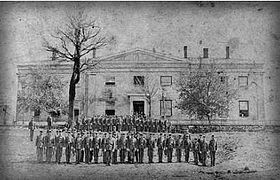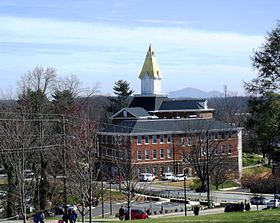History of the University of North Georgia
A few years after the war a former Confederate soldier and President of the Lumpkin County Board of Education by the name of William Pierce Price devised a plan to employ the land script of the Morrill Act to transform the old mint building into a college.
In essence NGAC was a liberal arts college, focusing more on courses such as law, Latin, Greek, English literature, theoretical mathematics, natural sciences, history, and philosophy.
Efforts of his such as working to disband the preparatory department, and eliminating the BS and AB degrees in agriculture were seen by much of the faculty and students as too progressive and needlessly ardent.
During a 1928 visit to the school, Governor Lamartine Hardman admiringly noticed the improved state of the university's campus and declared that he would seek a greater appropriation for the institution.
[4] There was initially discussion about closing NGC all together because of the school's dramatically declining student enrollment and its inconvenient geographic location.
This reclassification as a junior college caused all of the military elements pertaining to NGC, particularly the ROTC program, to be temporarily discontinued.
Recent administrations, particularly that of John W. West (1925-1932), had struggled to meet accreditation standards due to the subpar qualifications of much of the college's faculty.
[2] The growth seen under the Rogers administration was curtailed by the United States' involvement in World War II following the Japanese attack on Pearl Harbor in 1941.
In spite of the declining enrollment and economic hardship Rogers worked diligently to satisfy the Army's standards in order to preserve NGC's military program.
Not only was the military integrity of NGC preserved, but during this time it was the only junior college in the nation to have an (ASTP) Army Specialized Training Program.
On the eve of the Allied forces' invasion of German-occupied France war demands of the U.S. Army caused the ASTP at NGC to be discontinued.
As a response Rogers succeeded in acquiring an Army Specialized Training Reserve Program (ASTRP) in lieu of the school's lost ASTP.
The alumni were impressed by Rogers' achievement following the war, and they began to advocate for the reversion of the school back into a senior college.
On the other hand, Rogers was in favor of the school remaining a junior college that would specialize in technical training and preparatory programs.
Taking advantage of the state's new-found wealth the Georgia General Assembly decided to begin levying a 3% sales tax.
In the state's new favorable economical environment Rogers was able to secure a $29,000 increase in annual appropriations for the college as well as nearly $400,000 for new construction projects.
NGC's desperate campus-housing need was met in 1951 with the opening of the new Lewis Hall dormitory, which allowed the school to house twice as many female students.
The gubernatorial administrations of Carl Sanders and subsequently Lester Maddox fostered an unprecedented era of educational development in Georgia during the 1960s.
Perhaps the most recognizable structure made possible by this funding was the new academic building that was named for Edgar Brown Dunlap, who was the former chairman of the Board of Regents.
The new Dunlap building allowed for the much needed expansion of the business administration, mathematics, English, and modern languages departments.
Attendance at the college was further bolstered when, in 1968, it began to admit nonmilitary commuter students (not living in college-affiliated housing) for the first time.
One of the first black applicants to NGC was a girl by the name of Mary Wilson, who, in 1951, wrote a letter to Hoag inquiring of the possibility of her admission to the college.
Instead of answering directly, Hoag referred the letter to the Board of Regents, which simply reiterated the state's prohibition of racial integration in schools.
The ambitious building achievements of the previous Rogers and Hoag administrations allowed Owen to focus on issues other than a need to expand facilities.
The enhanced alumni association, in many ways, complimented the North Georgia College Foundation (NGCF), which was founded during the Hoag years to provide matching funds for federal student loans.
In 1988 Owen successfully persuaded the regents to allow NGC to offer two different bachelor of business degrees at the Gainesville campus.
[8] Nathaniel Hansford, a Korean War veteran and the former dean of the School of Law at the University of Alabama, assumed the presidency after Day.
In 1967, through a $2 million bond issue, Hall County and the city of Gainesville constructed facilities for the school at what is now its present location near I-85 on the outskirts of Oakwood.
This period was defined by increased construction activity as well as the initiation of the school's first four-year degree program, which was in the field of business administration.
In the early 2000s the college began a collaborative effort with the University of North Georgia to conduct research and analysis on the Chattahoochee River Basin.











